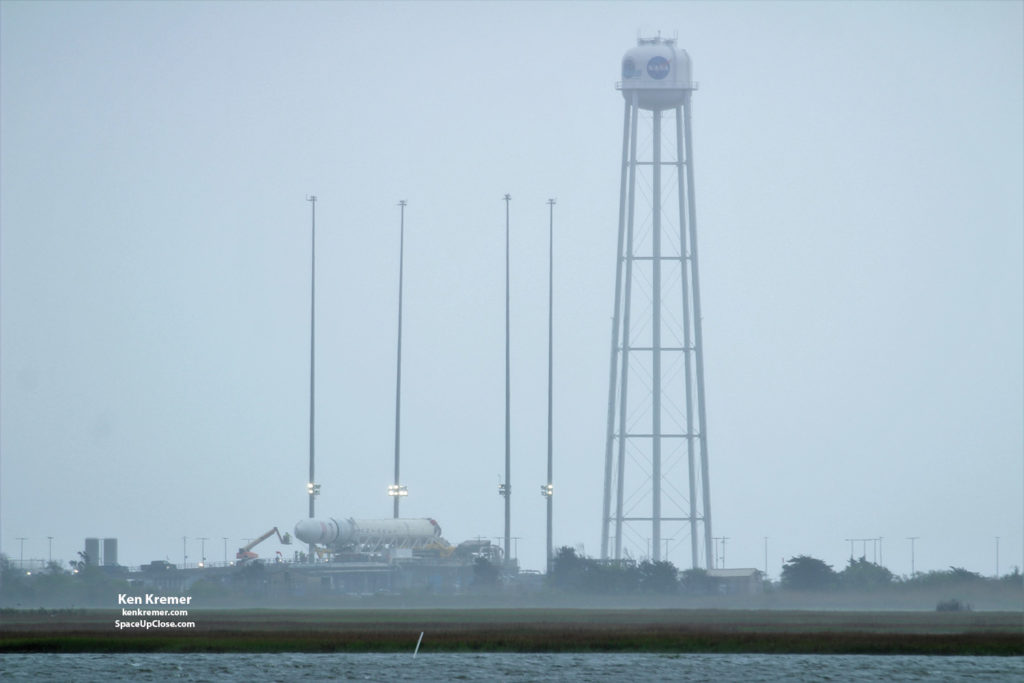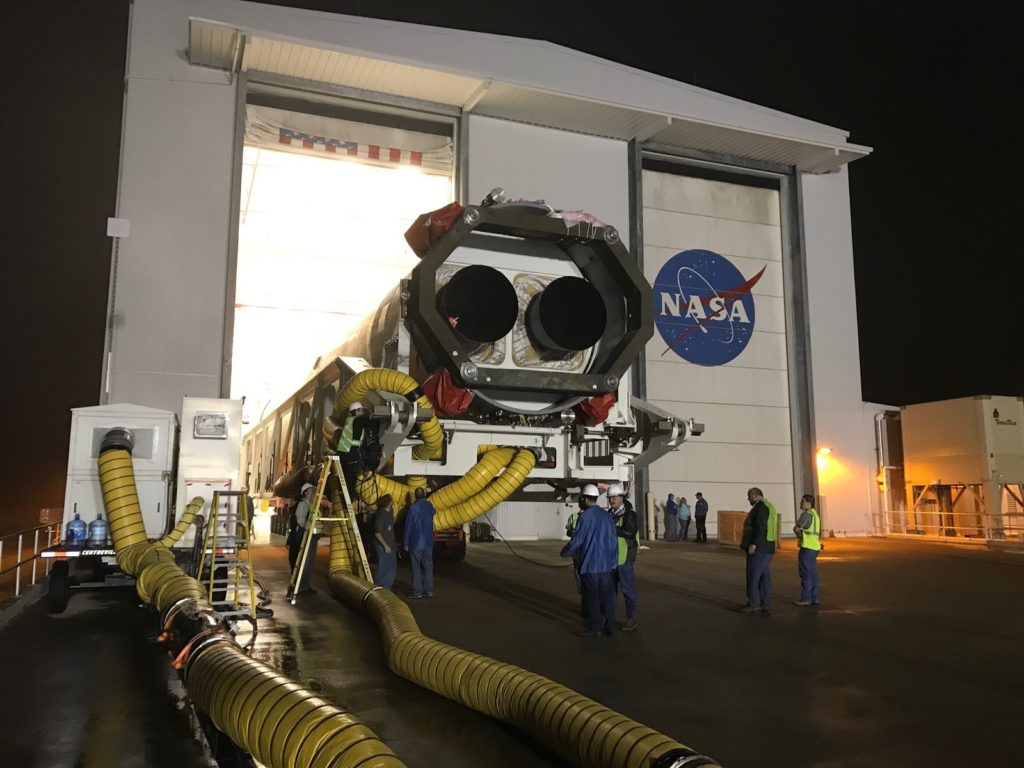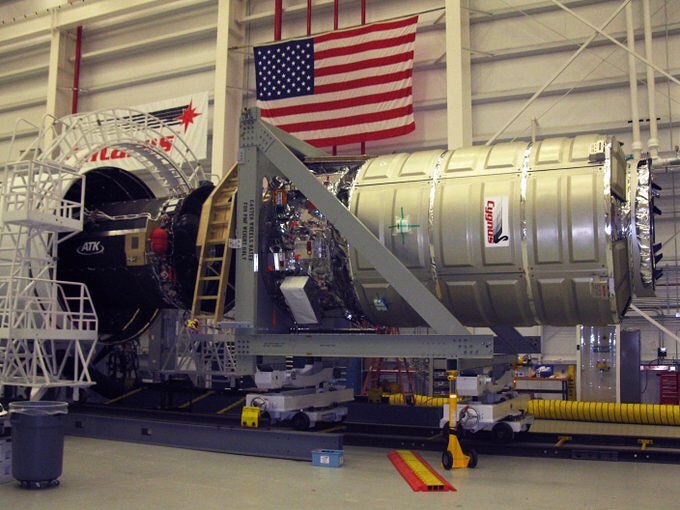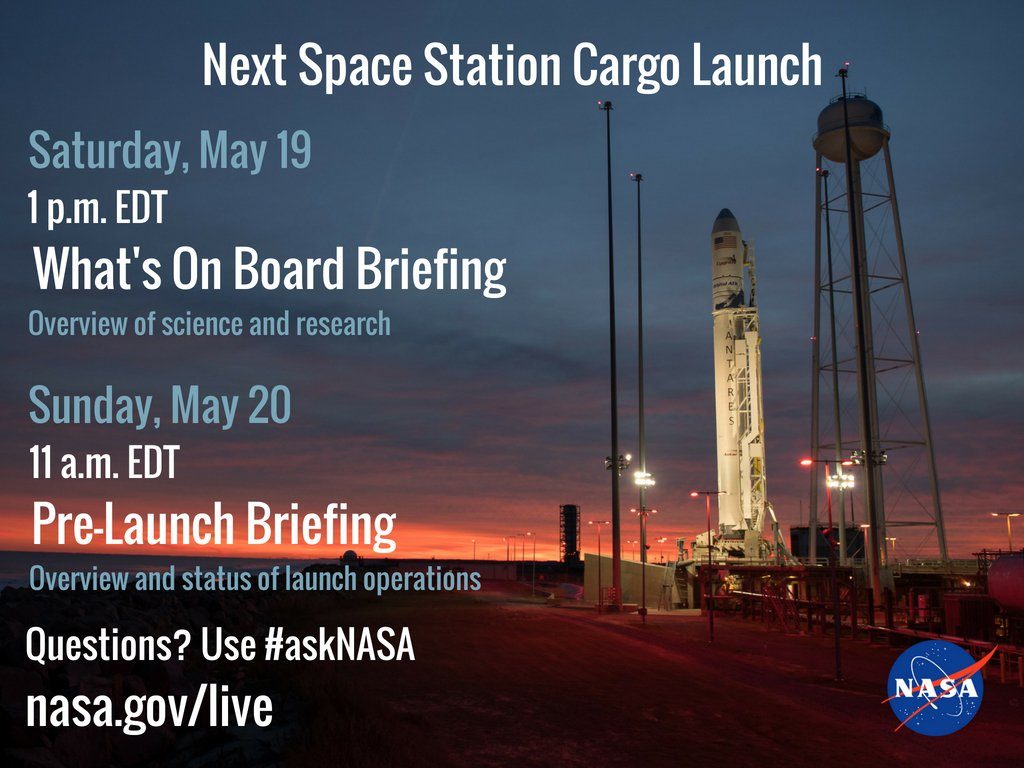|
Amidst drenching rain the Orbital
ATK Antares rocket has rolled out and is horizontal on pad 0A at NASA’s Wallops Flight Facility for the OA-9 cargo mission launch to the ISS. It briefly peeked out of the thick ground fog and technicians are readying the rocket for May 21, 2018 night launch at 4:39 a.m. EDT. Credit: Ken Kremer/SpaceUpClose.com/kenkremer.com |
ATK’s Antares rocket loaded with the Cygnus cargo spacecraft destined for the International
Space Station (ISS) has rolled out to the launch pad at NASA’s Wallops Flight
Facility on Virginia’s Eastern shore – even as drenching days of rain forced a days
delay to the nighttime liftoff now rescheduled to Monday, May 21.
Antares rocket carrying the Cygnus resupply spaceship is now slated for a 5-minute window that opens at 4:39 a.m. EDT May 21 from
Pad 0A of Virginia Space’s Mid-Atlantic Regional
Spaceport at Wallops.
resting horizontally at pad OA this afternoon May 18 during a brief break in
the rain and thick ground level fog.
|
Amidst drenching rain the Orbital
ATK Antares rocket has rolled out and is horizontal on pad 0A at NASA’s Wallops Flight Facility for the OA-9 cargo mission launch to the ISS. It briefly peeked out of the thick ground fog and technicians are readying the rocket for May 21, 2018 night launch at 4:39 a.m. EDT. Credit: Ken Kremer/SpaceUpClose.com/kenkremer.com |
230 launch vehicle and being maneuvered around on a
cherry picker- see my photos.
42.4 meters in height and 3.9 meters in diameter. The Cygnus has a pressurized volume of 27
cubic meters and is 6.39 m in height. It is loaded with 800 kg (1764 lb) of
propellants.
 |
|
Amidst drenching rain the Orbital
ATK Antares rocket has rolled out and is horizontal on pad 0A at NASA’s Wallops Flight Facility for the OA-9 cargo mission launch to the ISS. It briefly peeked out of the thick ground fog and technicians are readying the rocket for May 21, 2018 night launch at 4:39 a.m. EDT. Credit: Ken Kremer/SpaceUpClose.com/kenkremer.com |
much anticipated Antares launch had been set to take off at 5:04 a.m. EDT May
20, but was officially postponed earlier today because of several days of
nearly continuous terrible rain squalls inundating much of the US East Coast
from New York to Florida.
forecasters say there is an 80-percent probability of
acceptable weather for launch of Antares with Cygnus in the wee hours of Monday
morning.
Cygnus launch to NET Monday, May 21st at 4:39 a.m. EDT to support further
pre-launch inspections and more favorable weather conditions, Orbital SATK said
in a statement. “Monday shows an 80% probability of acceptable weather for
launch.”
rolled out of the Horizontal Integration Facility (HIF) late Thursday, May 17 for
the 1 mile trip from the rocket assembly facility to the OA launch pad at NASA
Wallops.
launch date was adjusted from May 20 to May 21 after the rocket rollout was
completed.
Cygnus vessel is jam packed with over 3.5 tons of science and supplies
bound for the six person multinational crew living and working aboard the million
pound orbiting outpost.
named CRS-9 or OA-9 , is Orbital ATK’s ninth contracted cargo delivery flight
to the International Space Station for NASA.
are 7,400 pounds (3,350 kg) of cargo including science experiments, research gear,
food, water, spare parts, crew supplies and vehicle hardware to support the
Expedition 55 and 56 crews.
|
Cygnus and Antares inside HIF at NASA Wallops. Credit: NASA
|
vital equipment, supplies and scientific equipment to the space station as part
of Orbital ATK’s Commercial Resupply Services (CRS) contract with NASA.
freighter was successfully launched by an Antares 230 vehicle from Wallops on
Nov. 11, 2017 on the OA-8 resupply mission for NASA .
on OA-9 are; the space Sextant Navigation investigation testing use of a
hand-held sextant by astronauts for emergency navigation on missions in deep
space as humans begin to travel farther from Earth; the Cold Atom Lab (CAL) is
a new facility that will create a spot ten billion times colder than the vacuum
of space, and could help us answer some of the biggest questions in physics; and Biomolecule
Extraction and Sequencing Technology (BEST), an investigation to
identify unknown microbial organisms on the space station and understand how
humans, plants and microbes adapt to living on the station.
cubesats from a Nanoracks supplied deployer.
aerospace industry and a member of the Orbital ATK family.
aerospace industry who helped shape the strategy and directed the operations of
Orbital ATK’s predecessor company, Orbital Sciences Corporation, for nearly 25
years. Before joining Orbital, Thompson was NASA’s Deputy Administrator from
1989 to 1991,” said Orbital ATK in a statement.
eight minutes after liftoff and begin an orbital chase
launch and a carefully choreographed series of thruster firings.
manage the spacecraft’s arrival,” said NASA. “Expedition 55 Flight Engineer
Scott Tingle will grapple the spacecraft, backed by Ricky Arnold, and Drew
Feustel will monitor Cygnus systems during its approach.”
Canadarm2 to grab the spacecraft and ground controllers will command the
robotic arm to rotate and install Cygnus onto the station’s Unity module.”
mission briefings over the weekend on Saturday and Sunday.
free from the NASA Wallops Visitor Center which opens at 1 AM on May 21.
 |
| Credit: Ken Kremer |
are Robert Reed Park on Chincoteague Island or Beach Road spanning the
area between Chincoteague and Assateague Islands. Assateague Island National
Seashore/Chincoteague National Wildlife Refuge in Virginia will not be
open for viewing the launch,” says NASA.
millions of spectators all along the US East Cost depending on clear weather conditions.
ULA, Boeing, Lockheed Martin and more space
and mission
reports direct from the Wallops Flight Facility, Kennedy Space Center and Cape
Canaveral Air Force Station, Florida.
Earth and Planetary science and human spaceflight news: www.kenkremer.com –www.spaceupclose.com –
twitter @ken_kremer – ken
at kenkremer.com
 |
|
Cygnus OA-9 Mission Profile. Credit: Orbital ATK
|






